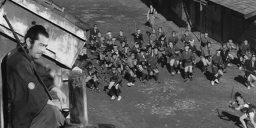FILMIC GRAMMAR: THE RULES OF FILMMAKING
 Steve K
Posts: 3,272
Steve K
Posts: 3,272
I recently watched "Yojimbo" (1961, Director Akiro Kurosawa) on the Criterion Channel, with a full commentary by Stephen Prince, American film critic and professor. He talked a lot about Kurosawa's "filmic" technique (depth of field, camera angle, layout on a wide frame format- see attached, etc.) I have done some reading on this, but I still tend to overlook the "rules" too often. Given the current interest here on animation, I thought this brief overview might be of interest:
https://2822digitalcinematography.wordpress.com/filmic-grammar-the-rules-of-filmmaking/


Yojimbo Wide Frame.png
1189 x 478 - 417K
Post edited by Steve K on


Comments
Thanks. Great stuff.
You're welcome. I do enjoy the "Making Of" features, some good ideas in there.
ditto - some very cool stuff in that link, tnx!
--ms
~ an interesting subject , none the less ~
You are quite welcome. Just to mention it, the article does talk about "breaking the rules", just not very often. Reminds me of a favorite saying, "You should always tell the truth, so that when you lie, people will believe you."
Some examples (mostly about the screen play, e.g. a movie about a diamond heist that never shows the heist):
https://thescriptlab.com/features/the-lists/1464-top-10-movies-that-broke-the-rules/
I think so. I have said that the good news about animation in Carrara is that you have complete control over every element. The bad news is ... you have complete control over every element.
When you get to the video editor, the water gets even deeper. Transitions, clip editing, special FX, sound effects, music ... I recall one famous director (Spielberg, maybe) talking about a movie from long ago. He said if he had his way, he'd still be editing it ... a decade or more later. One of the attractions of the 48 Hour Film contest is you just go ... no mulligans. Got a bad scene? Bend to fit, paint to match.
Maybe one can go too far in "breaking the rules", like an "X Rated" animation ... but it became the highest grossing independent animation, making $200 million worldwide.
https://www.imdb.com/title/tt0068612/
Ralph Bakshi did the movie 'Wizards' as well (a formative piece for me), and I think he was involved in 'Cool World' too. While the 'sex sells', thing is certainly universal, I think he is like a 'Prince' (of the music world) in the animation domain. Some folks just have a different perspective, and we're happy (and fortunate) for it when it works.
To be honest, I think Wendy is kind of a 'Prince' in our community, and I'm so glad I bumped into her here. I'm far more traditional, either out of fear or a simple lack of 'vision' - I'm happy, but far less interesting - so far. The inspiration persists.
Bless those with both new ideas and courage.
(thanks for the posts, @stevek),
--ms
You're quite welcome. Another movie that comes to mind is "The Tripletts of Belleville", the 2003 French animation. I recall a making of where the director said they worried about the US rating, since there was some cartoony, pixellated nudity and some other stuff not suitable for small children. E.g. one review (one star ouf of five): "What?? In the first 5 minutes, the movie starts with smoking cartoon characters, a topless dancing woman wearing only, well, either bananas or leaves around her waist, and a bunch of tiny people come onstage and pull them off her. It started out excessively mocking of obese people, which had no relevance to the story, and then became sad and bizarre ... "
Happily, it got a PG-13 nrating and a 7.7 score at IMDB. Critic Roger Ebert (3.5 stars oit of 4):
" 'The Triplets of Belleville' will have you walking out of the theater with a goofy damn grin on your face, wondering what just happened to you. To call it weird would be a cowardly evasion. It is creepy, eccentric, eerie, flaky, freaky, funky, grotesque, inscrutable, kinky, kooky, magical, oddball, spooky, uncanny, uncouth and unearthly. Especially uncouth ... "
So, yeah, a "different perspective".
I recently watched "Tunes of Glory" on the Criterion Channel (1960, 7.5 at IMDB). In a decades later interview, the director said he did not want the camera to be noticeable by the audience. So e.g. he would never cut during a camera pan, but let the camera settle to a stop first. He realized movies had gone to "cut,cut,cut ... " but that was not his style back then, he wanted the actors (Alec Guiness and John Mills in this case) to tell the story. There is an infamous 2015 movie clip floating around with 15 cuts in 6 seconds ...
Surveying the RKO backlot in Hollywood, Orson Welles said, "This is the biggest electric train set a boy ever had!" This was quoted in the context of a short documentary on the early Alfred Hitchcock, who was lured from England to the US by David O. Selznik, head of RKO. For me, this is the appeal of making animations in Carrara. I have (mumble, mumble) GB of actors, props, scenes, mocaps, sounds FX, music, special FX, etc. All great fun to assemble into a short animation, just need a story, the hardest part.
Attached: RKO Forty Acres Backlot (site) - Culver City, California
P.S. Anyone else play the old PC video game "The Movies"? You run a movie studio including a huge backlot with lots of sets, actors, etc. Lots of fun, screen grab attached.
Thanks for the graphic reminders.
Ditto.
Spike Lee techniques:
Faces in the Crowd, the double dolly shot, squeezing the frame.
The first two look interesting, the third one just looks wrong.
https://www.nytimes.com/2018/08/02/movies/spike-lee-movies-visuals.html?campaign_id=20&emc=edit_wg_20220629&instance_id=65349&nl=watching®i_id=1017515&segment_id=97148&te=1&user_id=b85b4e9f39030ce135e20f256002176d